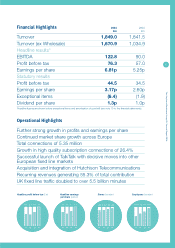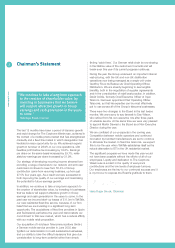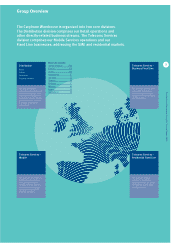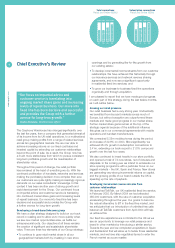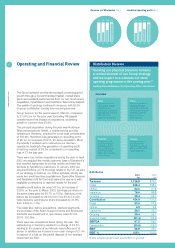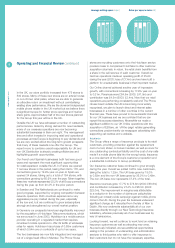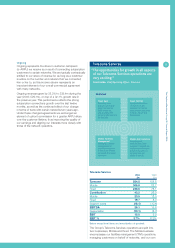Carphone Warehouse 2004 Annual Report Download - page 12
Download and view the complete annual report
Please find page 12 of the 2004 Carphone Warehouse annual report below. You can navigate through the pages in the report by either clicking on the pages listed below, or by using the keyword search tool below to find specific information within the annual report.
10
www.cpwplc.com
Operating and Financial Review continued revenues of £211.1m and an operating profit of £9.1m in its
first ten months within the Group. In the current year we
intend to invest in growing the current base of 0.69m
customers more aggressively.
Our other own customer operations, predominantly Fresh,
our UK virtual network, suffered during the year as the
incumbent networks continued to make aggressive offers
in the pre-pay market. Total customer numbers were flat
on the year at 0.12m.
Fixed
Our fixed line operations have had a very successful year.
Opal, our business-to-business network provider which
underpins all of our fixed line activity in the UK, generated
revenues of £218.4m and contribution of £30.6m in its first
full year within the Group. Opal continued to win new clients
through a combination of bespoke value-added services
and its ability to offer very competitive voice tariffs to the
SME market.
Total business traffic over the network increased by 64.3%
on a pro forma basis to 4.51bn minutes. The difference
between revenue growth and traffic growth in Opal arose
from a change in business mix during the year, with high
per-minute revenue, low margin premium rate business
representing a lower proportion of traffic than in the previous
year. Including TalkTalk activity, total traffic increased by
100.5% to 5.52bn minutes.
Opal has a clearly focused engineering strategy that
directs investment towards those elements of the network
that create cost efficiency and allow us to add value to
customers. During the year it provisioned two switches,
taking the total to six, with plans for a further four in the
coming year. Investment in switches not only allows Opal
to manage the rapid rise in call traffic but also to build its
own software layer into the network through which it
provides a number of services to corporate customers,
particularly in the areas of call recording, call queuing
services and database management.
The other main area of investment for Opal is in the
development of a deeper level of interconnect into the BT
exchange infrastructure, since the extent to which the Opal
network is connected into the BT network has a significant
impact on the price we pay BT for carrying calls. A call that
is originated onto the Opal network at the local exchange
level is 27% cheaper than a call originating at the regional
exchange level. By March 2004 we had aimed to originate
30% of traffic at the local exchange layer but actually hit
60%, creating significant additional network efficiency.
We are targeting a figure of 75% for the coming year.
The final element of network infrastructure – the fibre
backbone connecting our switches – is leased from
a number of operators. There continues to be significant
excess fibre capacity in the UK market and the cost
214 1,019 1,115 1,973
03 04 02 01
Mobile managed base (000s)
1.2 1.6 2.3
H1 04H2 03H1 03
3.2
H2 04
Opal switched minutes (bn)
customers, including our virtual network, Fresh, and our
German service provision business, Hutchison (now renamed
The Phone House Telecom). The Fixed business comprises
Opal, our business-to-business network, and TalkTalk, our
residential service, both in the UK. Going forward as we
build up our non-UK fixed line operations, these will be
split between business and residential as appropriate.
Telecoms Services revenues grew by 249.3% year-on-year
to £554.5m (2003: £158.8m), boosted by the full year
impact of acquiring Opal and the acquisition of Hutchison
in June 2003. EBIT increased by 51.9% to £15.0m (2003:
£9.9m). The EBIT margin declined from 6.2% to 2.7%
as a result of the lower margin Phone House Telecom
revenues, and the start-up losses in TalkTalk of £11.0m.
Mobile
We work increasingly closely with network operators
to attract and retain high quality customers, and to
generate more value from our customers beyond the point
of sale. Overall we achieved revenue growth of 270.0%
to £305.9m (2003: £82.7m), with contribution up 30.8%
to £23.5m (2003: £18.0m). Stripping out the effect of the
Hutchison acquisition, revenues grew by 14.6% to £94.8m
and contribution fell by 28.9% to £12.8m. Overall
profitability for this business was negatively affected year-
on-year by the transfer of a service provision base back
to SFR in France just before the previous year end.
We achieved good organic growth in our UK FM business
with customers managed on behalf of O2 and Vodafone
growing by 42.5% to 0.56m (2003: 0.39m). This was
boosted in part by an agreement with Sainsbury’s, the
supermarket chain, to provide mobile services to its
customers in association with O2. We continue to manage
0.6m customers in France on behalf of Orange and SFR.
The key drivers of our FM businesses are the number of
customers under management, the customer ARPU, and
the efficiency with which we manage our call centres and
bad debt. During the year we opened a second UK contact
centre in Birchwood to address the additional volumes
of FM and TalkTalk customers under management.
Within our operations managing our own customers, the
major highlight of the year was the acquisition of Hutchison
in Germany. This now represents by far the most significant
element of our own customer operations, and recorded



